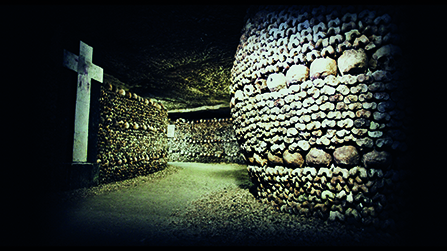Press roundtable - Catacombes – Our talk with John Erick Dowdle & Drew Dowdle
By Mulder, Paris, Mandarin Oriental , 04 august 2014
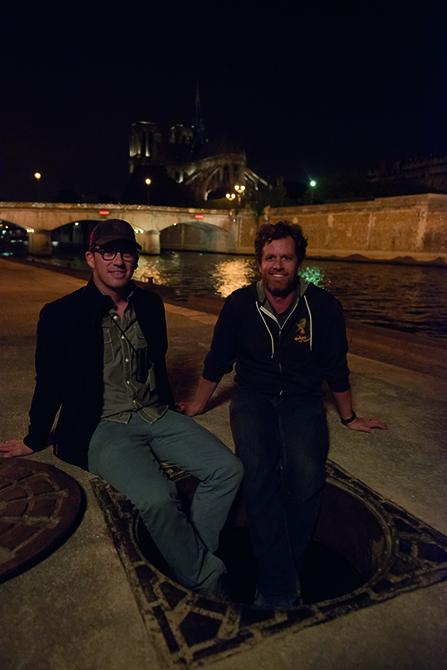
Q: Now that we’ve seen the film, it seems like the most obvious idea in the world to shoot a horror film in the catacombs. It is amazing that anyone has done it before. How did you have this idea ?
John Erick Dowdle : Drew and I always wanted to do a kind found footage Indiana Jones type adventure. So we have been talking about that. But we didn’t have a setting or really anything more than that. Thomas Tull of Legendary Pictures called us and said that he wanted us to do the film in the Paris catacombs. We had traded photos back and forth and studied it.
Drew Dowdle : Several years before that, that was one of those ideas that, for a second, came up and then got pushed aside.
John Erick : We thought that it would be perfect for this thing. We wanted to do this kind of alchemy Nicolas Flamel thing. But how do you tie that in to the catacombs ? The cemetery he was allegedly buried in was the first cemetery that moved down to the catacombs. So, this all kind of connects together. We just started from there.
Drew: From that meeting with Thomas Tull and Jon Jashni : we basically spent two weeks. These two ideas really mix, they really bring fusion here. We asked them to give us two weeks to come back with a more fleshed out story. We came back and they liked what we were saying. And we were on a plane for location scouting two weeks later. That was quick.
Q: When was the first time that you actually went down to the catacombs ? How did it feel ?
John Erick: The first time we did a location scout out here, we went through this big long train bridge that went through a hole this big.
Drew : The same place where they go through in the movie, on the train tracks.
John Erick: We go through this hole and this little corridor. We are in waders, up to our chest in water and crawling under things. About fifteen minutes in, I started to feel like I was burning inside, like “Oh my god, I have to get out of here”. But then I thought that I’d have to get over this or they’ll replace me and get someone else to do it. We kept going and going. We went for almost five hours that first time, just trying to get used to it so that we wouldn’t freak out when we were there.
Drew: Our first stop was the south system which was by far the most difficult and scary off-limits section. We started with the toughest one. Like John said, we were crawling on our elbows and knees for hundred meters just to get in. If you get lost in there, if you lost our guide Gilles Thomas, you would never find your way out.
John Erick: One of the people we brought with us totally freaked out. We won’t name names. Thankfully it wasn’t us. He screamed, “this is so irresponsible, get us out of here !”. We had to calm him down in a tight space like that.
Drew: You could understand that, once he started to unravel, he wanted to get away from there.
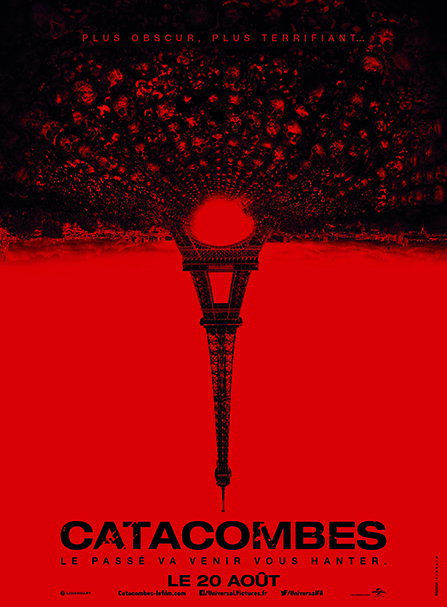
Q: Now you are found footage and false footage documentary experts, how did you approach the visual look of the film ? As a mixture of, like you said, Indiana Jones and horror ? I imagine it must be quite difficult to stay in the illusion that it’s all filmed by the characters.
John Erick: We wanted it to not feel like a found footage movie. We wanted to have the effect, the visceral “you are there” feeling of a found footage movie. But we didn’t want to make a found footage movie in the catacombs. We wanted it to be more than that, to feel more cinematic. To shoot down in the catacombs meant to shoot in a traditional manner. We shot really down there. We shot the real thing. If you shot there traditionally, it would cost you a hundred million dollars to set up the lights and bring down the generators. It would ruin the effect. So, the actors are actually lighting the scenes themselves with their head-lamps. When you see Scarlett running with the camera, she is really shooting herself. We like to embrace that reality. There are a couple of times when she asks how to put her camera. It was like giving her camera directions. It was awful. We wanted the blacks to be rich, not feel super video. We wanted it to feel beautiful. So many times, found footage feels like crappy video. These people have good cameras. They know what they’re doing. We wanted it to feel cinematic.
Drew : We found that the less attention you draw to the conceit of the camera, the more people just let it fall into the background. For this one it was really quite easy, because you set the cameras on the characters’ head and that’s where the light is. The camera is following the light all the time. You don’t think about the fact if they would still be filming this. Those questions fall in the background. It is just part of what is guiding them through the space.
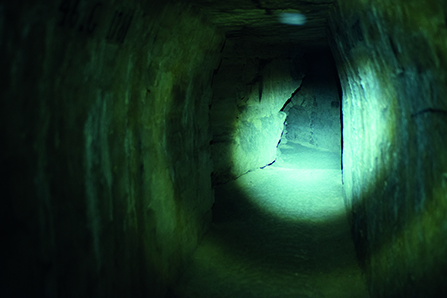
Q: How many scenes did you shoot down in the catacombs ? There must be some scenes that you shot in a studio ?
John Erick : Almost everything. When they swim through the water, both sides of that are built. We brought the car and the piano down in the catacombs. That’s all real. When we crawled over the bones, we supplemented a wall in there, but that is really down in Cochin, six stories underground. The actor is genuinely claustrophobic and that was only the second day of shooting. That’s hardly acting, it is a great performance because he was really dying inside. We think that his head had would have exploded, if we continued to work in this place. That’s all we needed !
Drew : Yes, it was almost entirely practical.
John Erick : The bones were not real. When you do the tour, those bones are obviously real. We actually saw during our first tour a very small tunnel with real bones and skulls. We took photos of ourselves with the skulls.
Drew: We felt kind of guilty about it afterwards. We didn’t drink wine out of a skull or anything weird like that. Our production designer Louise Marzaroli had a full bone factory going at the studio. We have a room full of bones in our home, fabricated. We love them, they look totally real.
John Erick : We wanted real heavy bones, not light plastic ones. You couldn’t tell the difference if you held that bone and a real bone. They did a great job with that.
Q: You have written the movie together. How much has the architecture of the writing been influenced by your first visit to the catacombs, your first time down there, seeing them ?
John Erick : We have written a couple of drafts before we went down there. We like to consider our screenplays more like jazz than Mozart. This is our starting place, let’s see what the actors bring to it, let’s see what the spaces bring to it, let’s see what the cinematographer brings. We like to keep it a little loose and allow for real moments and reality to see what happens. Going down in the catacombs, there is a bunch of stuff, like going through the water. Realizing that this is something that happens down there and that’s super scary. So, let’s do that. Seeing the real bone tunnel is like that. What if we crawled in that place, wouldn’t that be morbid ? Let’s look at people doing that.
Drew : Before we went on location scouting, we were looking through a lot of photos and images : statues in the wall, the bone tunnel, things like that. They really came into the screenplay before our location scouting, based on photos, basically a virtual location scout. But like John said, a lot of it was improvised once we actually had the space.
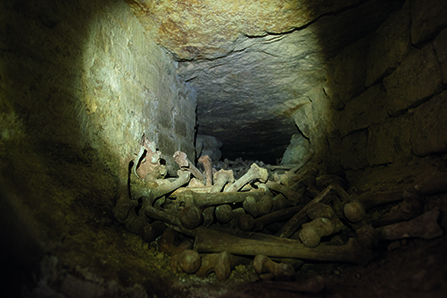
Q: When you were working on plot, how did you connect exploring the Catacombs and facing your own fears and sins ? What was the idea behind that ?
John Erick : When you go down there, it’s scary. I think that there is a natural way. In my own life, when I was in my twenties, I hid from everything that scared me on a personal level. At some point, I decided to face things head on. For me, that was a really meaningful change in my life. We often talk about forcing you to face the things you’re scared to deal with.
Drew : When we started to go down the Flamel path and the Philosopher’s stone path, I think that really informed that direction. It’s about purification and purifying one’s soul. We thought that would be a really nice way to get in the idea of regret, of what weighs you down and facing those fears and personal demons.
John Erick : We’ve been studying the Egyptian hieroglyphs. There is an underworld where, when you die, your soul or your heart is weighted against the weight of a feather. If your heart is heavier than a feather, then the dog eats it up and you go to hell. We like the idea to weight your soul against a feather down in the catacombs. It has a hidden underworld feel to it. It is sort of esoteric. That is how we throw a lot of weird stuff at each other and eventually find our way through it.
Q: The mythology of the film seems very solid. It touches on enough that we know that we can make a connection to it. It embellishes where it’s needed to find the horror. Do you think that is the secret behind scaring people ?
John Erick : Yes it is. You always read about Flamel and the Philosopher’s stone. Did this guy really die or does he live forever ? There is something scary about this. Is it possible that this guy from the 1300s is still cruising around out there ? We went to catholic school growing up, so everything that’s a little bit voodooish sounds super scary to us. It is a really fascinating version of history. It is really fun to explore. If you work on a movie for a couple of years, you really want stuff to geek out on. This is a really fascinating world.
Drew : We love the idea of a found footage movie exploring and embracing a supernatural element. We wanted to base it in some real history. We thought that would be a good jumping-off point to come to a supernatural space.
Q: Has Nicolas Flamel seen the film yet ?
John Erick : We hope to screen it for him this week. He looks pretty good.
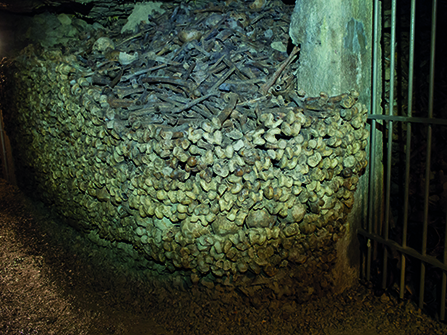
Q: Could you talk about your collaboration with Legendary ? Did they come to you with the project ?
John Erick : It was sort of a hybrid. We were about to go to another movie. It collapsed literally the day before we went to go shooting. We asked ourselves what we were going to do. It was like a godsend. We knew that something good had to happen. Thomas Tull, the head of Legendary, called us literally the next day. He said that he would do something in the Paris catacombs and he asked if we had any ideas. We said yes and asked if we could come in the following day to pitch him an idea. Two days later, we talked to him about Nicolas Flamel and all this crazy stuff. Either he would think that was awesome or ask us to leave. Thankfully, he loved it. And we started working on it right away.
Drew : We had a loose story about Scarlett Marlowe, the daughter of an alchemist and a found footage female Indiana Jones character. We had that part and Thomas had the catacombs. That was a great fit. We came in and went on from there.
Q: Your next project sounds more like a political thriller. Can you already tell us something about it ?
Drew : Sure, it is not as political as it may sound.
John Erick : It’s more of a survival story. A husband, his wife and their two little girls go to a foreign country for a job. A coup overthrows the government and all hell breaks loose. Not knowing anyone there and not speaking the language, they have to get out of the country. Anyone ever changes their clothes in our movies. They start the movie and they end the movie in the same clothes. It’s just more tattered at the end. They generally don’t smell very good by the end of the shoot.
Drew: Like As above, so below, it’s a crisis, when something happens and it’s an escape from this crisis.
Q: I am interested in your general opinion towards the found footage. It’s always called a genre, but it is actually a style or an aesthetic. You could compare it to other kinds of realism in cinema. The genre just came up because now we have the means to tell stories like this. It is also very close to our perception of reality. We all have smart-phones and cameras everywhere. Why is this “genre” still relegated to mostly horror movies or rite movies ?
John Erick : I think that will continue to expand. I think there will be kids movies, as more and more people get used to the factor of watching stuff on youtube. With my five-year old, I’m watching dancing cats. Everyone is used to that style now. Documentaries have been around forever. Movies like Battle of Algiers have been using that style forever. Average shot stuff looks like your friend could have shot that. I think it is a part of our language now. The system Oculus will permit to feel more and to merge into general film making.
Drew : I think even comedies will embrace that style fully. When we made The Poughkeepsie Tapes, people making found footage seemed really intent on convincing audiences that what they were making was real. Now it’s a really different world, where you can embrace the fictional nature of it. Audiences don’t care if it’s real or not, they just want it to feel real and entertaining. It is more like an aesthetic than it is kind of a gimmick.
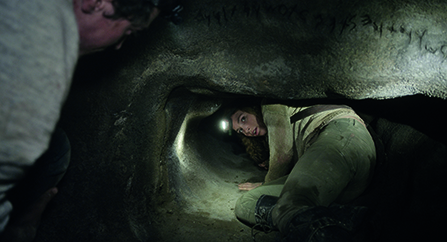
Q: Is there something lost in constructing the image ?
John Erick : We like to say before starting a new project, you have to define the straight jacket you are in. Once you know that straight jacket, you can figure out how to move within. One of the many things with found footage is that you are not expecting to see everything. In that, you can make things so much scarier. If I have to go around this door, I’m with the character going around the door. I am not expecting a cut outside to see what’s on the other side and then come back. There’s something nice in not cross-cutting. The actors kept telling us that they never knew when the camera was going to turn and film them. They had to bring everything to every take. They could not wait for their close-up to sizzle. They had to bring it just in case the camera’s spot on them. It keeps everyone on their toes. It creates a real living, breathing thing. If you’re trying to capture something that feels like reality, you have to shoot it like reality. They never saw Leto before they were down there. We kept the actor of Leto totally separate from the rest of the cast. The first time they saw him was actually down in the caves. When they heard something, they turned around and he was there. On camera was the first time they saw him. When you see him for the first time, that’s the first time they saw him. The same thing with the piano and that whole hallway, they’ve never been through there. Over and over, we tried to really protect the reality of the discoveries of what they knew. I think that is part of the fun of found footage : trying to simulate reality.
Drew : We can do very long takes with the actors. They can really get into the scene. Their performances really indicate that. That aesthetic has really informed us as filmmakers. We shoot longer, five or six minutes, with three cameras. We tell our operators that it is fine, if you’re seeing other cameras, it’s cool. We’ll edit around that, just keep it going. The actors really shine within these long takes that are more theatrical.
John Erick : The French cinematographer will come along with us to the next movie. He was cool, he didn’t want to set marks or plan anything. He just figured it out on the flight. He was so good at this that we’ll keep him on the next one, too. He was amazing. It’s a crazy way to shoot but it’s really fun. The actors loved it.
